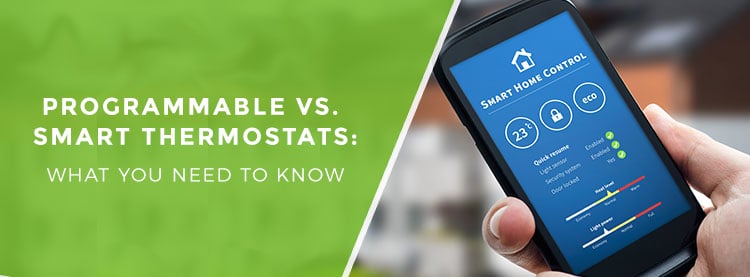
For a long time, thermostats remained one of the simplest components of a home heating system. Many people who live in older buildings still rely on manual thermostats, which allow you to simply dial in the temperature of your choice. While easy to use, this type of thermostat has a number of drawbacks, including its limited accuracy and inability to perform automatic temperature changes.
In recent years, digital thermostats have largely come to replace manual units. Digital thermostats offer greater precision, more programming options and, with the introduction of “smart” technology, the ability to make temperature changes over your home’s Wi-Fi network.
Programmable Thermostats
First-generation digital thermostats are simply refined versions of older manual models. Instead of dialing in the temperature you want, they feature a large digital display that allows you to adjust the performance of your furnace or A/C with greater accuracy — usually within 1˚F.
Programmable digital thermostats take this technology a step further, giving you tools to automatically make global temperature changes in your home. The main benefits of a programmable thermostat vs. non-programmable are convenience and cost savings. For example, if your home is empty during work days, you can program your HVAC system to run minimally while you’re not there, and warm up or cool down automatically in advance of your return.
This saves you money on your monthly utility bills while still ensuring you come home to a comfortable temperature. So: are digital thermostats better than the other options? Let’s take a look.
Smart Thermostats
Different types of thermostats have different pros and cons, but one of the most common complaints about older programmable units is their cumbersome, confusing interfaces. Many models have a steep learning curve — often, the more features a thermostat has, the more difficult it is to program correctly.
That’s where smart thermostats come in. The difference between a Nest, EcoBee or other smart thermostat and an older programmable model is comparable to the difference between an iPhone and a flip phone. While both get the job done, smart thermostats, like smartphones, are more fully featured, easier to use and better integrated with your daily life. With a smart thermostat, you can:
- Make temperature changes and create heating/cooling schedules simply.
- Use Wi-Fi to control your thermostat from your phone, computer or tablet.
- Monitor your energy consumption in real-time and track the effectiveness of your HVAC system.
Of all the types of thermostats on the market today, smart models are the most advanced and, for many, the most intuitive. However, all this technology comes with a price: while smart thermostats can potentially pay for themselves over time, they do have a higher initial purchase price.
Ultimately, your budget, your level of comfort with technology and the amount of time you plan to stay in your home will determine which type of thermostat is best for you.



